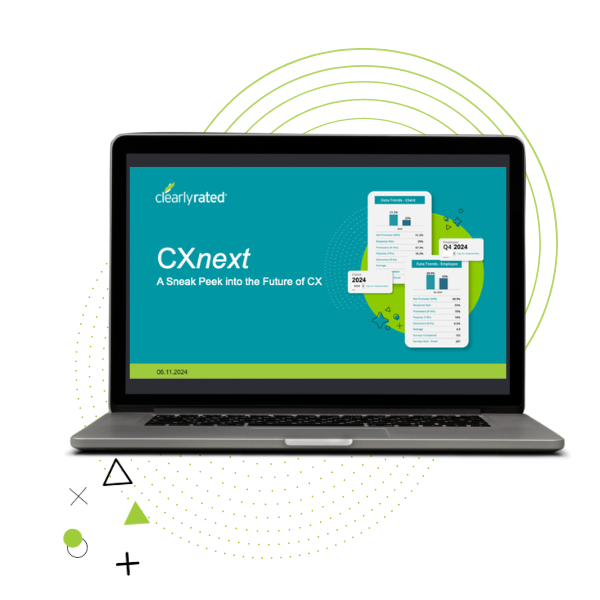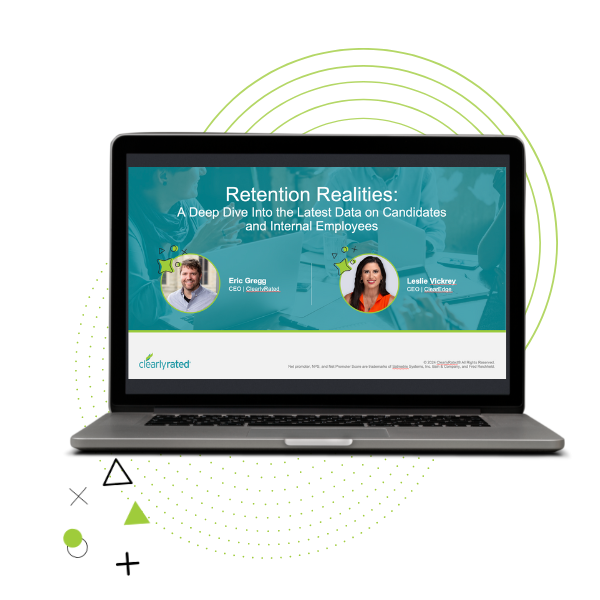Staffing Firms Can (and Must) Hold on to Their Talent
Virtually every business leader understands the importance of customer experience (CX). And, thanks to historically high turnover, most are grappling with a forced reckoning related to employee experience (EX). But staffing companies must deal with yet a third ‘X’: Talent experience (TX). How do they juggle all three? Well, they’re actually interrelated.
To explore how the three X’s dovetail, especially in today’s competitive labor market, ClearlyRated’s CEO Eric Gregg led a webinar for the American Staffing Association (ASA) with guest speaker Daniel Culbertson, senior economist for the Indeed Hiring Lab. Their mission: To explain why firms must prioritize employee experience (EX) alongside client experience (CX) and talent experience (TX)—and how to do it.
Daniel shared insights about the current playing field using proprietary data from the Indeed Hiring Lab. Then, he and Eric discussed how firms can win the hiring and retention game. In case you missed it, the recap with key insights is below, but don’t miss out on the full webinar. Watch it on-demand with an ASA member login: The Rise of Employee Experience and Client Experience.
Key Insights: The Labor Market Playing Field
Like any economist worth his salt, Daniel described the labor market using supply and demand. When it comes to supply, the U.S. is roughly 2.5-3 million workers shy compared with pre-pandemic numbers. And while demand lowered by 20 million jobs at the start of the pandemic, the tides have turned. Companies are hurting for people to fill their jobs. While supply is low, demand is now high. In fact, U.S. job postings on Indeed are 61% higher than the pre-pandemic baseline. For details on which occupational sectors have the steepest competition and which are faring best, watch the webinar.
 So, what’s driving this depressed supply of workers (both employees and talent for staffing companies)? We all know about the Great Resignation, the Turnover Tsunami, the Employee Exodus, but that relates to participating members of the workforce. What about those who were forced out of a job early in the pandemic and haven’t yet chosen to come back? Why haven’t they returned? Will they? Daniel shared data from a recent Indeed Hiring Lab Job Search Survey, exploring potential answers for the nonexistent rebound in people looking for work:
So, what’s driving this depressed supply of workers (both employees and talent for staffing companies)? We all know about the Great Resignation, the Turnover Tsunami, the Employee Exodus, but that relates to participating members of the workforce. What about those who were forced out of a job early in the pandemic and haven’t yet chosen to come back? Why haven’t they returned? Will they? Daniel shared data from a recent Indeed Hiring Lab Job Search Survey, exploring potential answers for the nonexistent rebound in people looking for work:
- Unemployment payments did not account for most people who stayed out of the workforce, so the tapering of those payments hardly made a dent.
- Many people have chosen to take early retirement.
- Disruptions to in-person school and daycare continued throughout 2021, even after vaccinations were widely available.
Indeed’s Job Search Survey showed that, while COVID fears have lessened, “care responsibilities” are increasingly keeping unemployed workers from looking for jobs (even after the school year started). And it doesn’t help that the childcare sector has experienced a nosedive in job seeker interest. Daniel pointed out that disruptions to school and childcare disproportionately affect fields that tend to be filled mostly by women as well as industries and companies that depend on part-time and temporary workers (hi, Staffing!).
Yet another challenge for staffing is that the HR field is aggressively hiring. “And where does HR love to find its talent?” Eric asked. If you’re in staffing, you know the answer: From recruitment firms. As a result, the two staffing roles with the highest turnover are account executives and recruiters. Our current labor shortage, therefore, hits the staffing industry in two ways: a low supply of talent for placements and a struggle with internal retention.
For more information, including turnover data broken down by gender and race/ethnicity, watch the webinar.
What You Can Do About It: The Rise of EX
So why is EX so important? According to Eric, it’s the first ‘X’ to focus on: “Internal employee retention and engagement mark where companies will win or fall behind during the next couple years.” Think about it: If you can’t keep good employees with positive attitudes, how will your CX fare? What about your TX? When you can’t hold onto your people, you risk underserving both your talent and your clients. Internal staff stability is, therefore, key to growth.
If you can succeed with EX, your firm will gain the competitive advantage of continuity, keeping good people who deliver outstanding CX and TX. Firms that fail at EX will flounder. As their internal talent leaks away, so will their external talent pool. And as that pool shrinks, so will their client rosters. So, work to keep your employees. Understand what they want and how you can deliver it, realizing that what you want and need from a job may not align with their wants and needs. We touched on this topic in a blog post highlighting the importance of DEI and CX, relating directly to EX.
As Daniel pointed out, report after report shows that what most employees want right now is flexibility. According to Indeed data, remote work continues to bring heavy interest from job seekers. That’s not groundbreaking news, but employers aren’t responding quickly enough. Just 7% of employees want to be in an office full-time, yet 38% of companies remain in office environments full-time. Just keep in mind that an increasing number of companies offer remote work, so you can’t count on this as your main differentiator when it comes to flexibility. Given the nationwide struggle with dependent care, consider how to offer flexible options that better support parents and caregivers beyond working remotely.
Finally, good workers are in high demand. That means other employers will pay to poach yours. You may have dabbled in short-term hiring band-aids like signing bonuses, but if you want long-term retention, then growth in base pay is essential. That’s especially true when you pair the tight labor market with inflation. Employees’ costs of living are rising. At the same time, they see evidence both of their strengthened negotiating power and of increased mobility between careers. Yet Forrester analysts made the bold prediction that 100% of organizations will fail to appropriately adjust compensation this year. Don’t prove them right. Check your compensation and adjust accordingly to market demand.
Companies that anticipate employee needs (and proactively provide for them) poise themselves for victory on the talent playing field. Want more? Use your ASA login to view the on-demand webinar for more data, trends, and takeaways (plus earn ASA CE credit and/or 1.0 PDC for SHRM-CP® or SHRM-SCP®).




